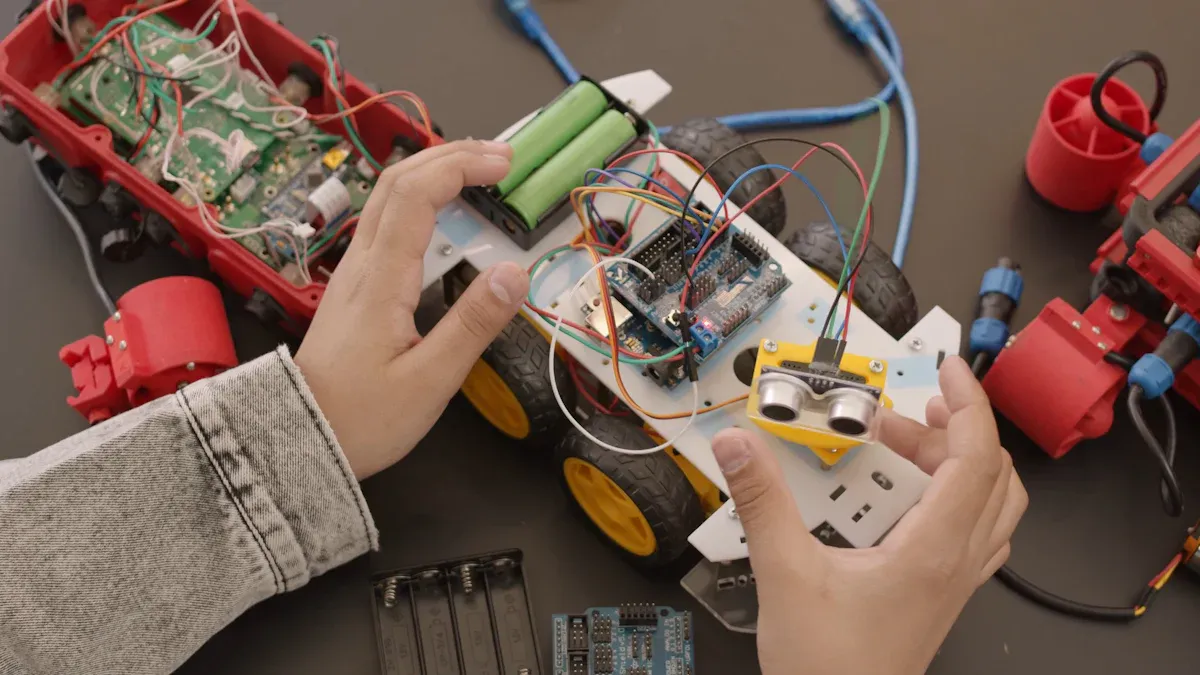
You may notice that li-ion battery connectors and lipo battery connectors look similar, but each connector serves a unique purpose for its battery type. You should never swap a li-ion battery connector with a lipo connector. This can cause serious safety risks and harm your device. Lipo batteries often require special connectors because they use a different electrolyte and need balance charging. Always check your battery connectors to match the correct connector for your lipo or li-ion battery. Using the right connector gives you better performance and keeps you safe.
Li-ion Battery Connectors
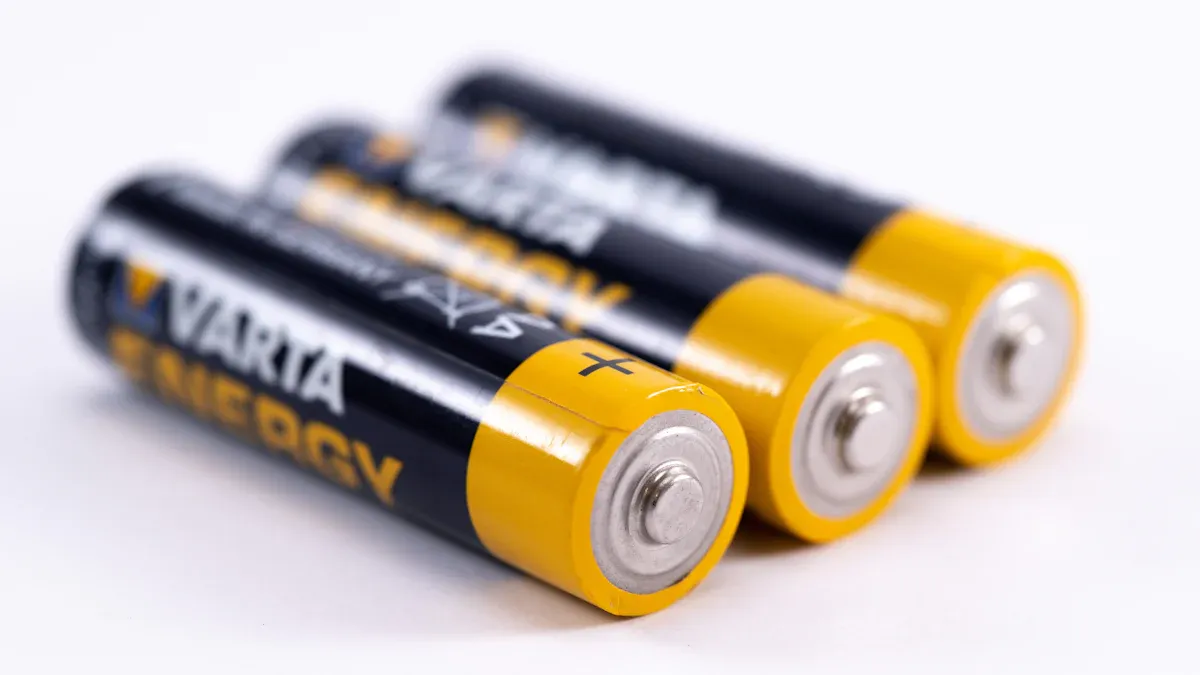
Types
You will find many types of li-ion battery connectors in both consumer and industrial devices. Each connector type supports different battery capacity and current needs. Here are some of the most common types you might see:
- JST connectors work well for small devices like drones and robotics. Their compact size fits tight spaces.
- XT60 connectors handle high current and suit RC cars, drones, and other high-performance hobby gear.
- Anderson Powerpole connectors offer strong durability. You often see them in amateur radio and emergency power systems.
- Molex connectors provide secure locking. Many automotive and industrial machines use them.
- SAE connectors appear in solar panel setups and battery chargers.
You can also find DC connectors, Deans (T-plug) connectors, and bullet connectors in many hobby and RC applications. Each connector type supports a specific battery capacity and current rating. The right choice depends on your device and how much power it needs.
| Connector Type | Typical Current Rating | Typical Applications (Consumer & Industrial) |
|---|---|---|
| JST Connector | 1~3A | Small consumer electronics, portable devices |
| Molex Connector | ~5A | Consumer electronics, automotive, industrial automation, medical devices |
| DC Connectors (DC5521, DC5525) | 3~5A | Laptops, LED lighting, routers, surveillance, audio equipment |
| XT Connectors (XT30, XT60, XT90) | 30A to 90A | RC vehicles, drones, electric bikes/scooters, industrial equipment |
| Anderson Powerpole | 15A to 300A+ | Electric vehicles, robotics, renewable energy, amateur radio, industrial use |
| Deans (T-plug) Connector | Up to ~40A | RC vehicles, power distribution systems |
| Bullet Connectors | 25A to 200A+ | RC vehicles, electric motors, automotive electronics |
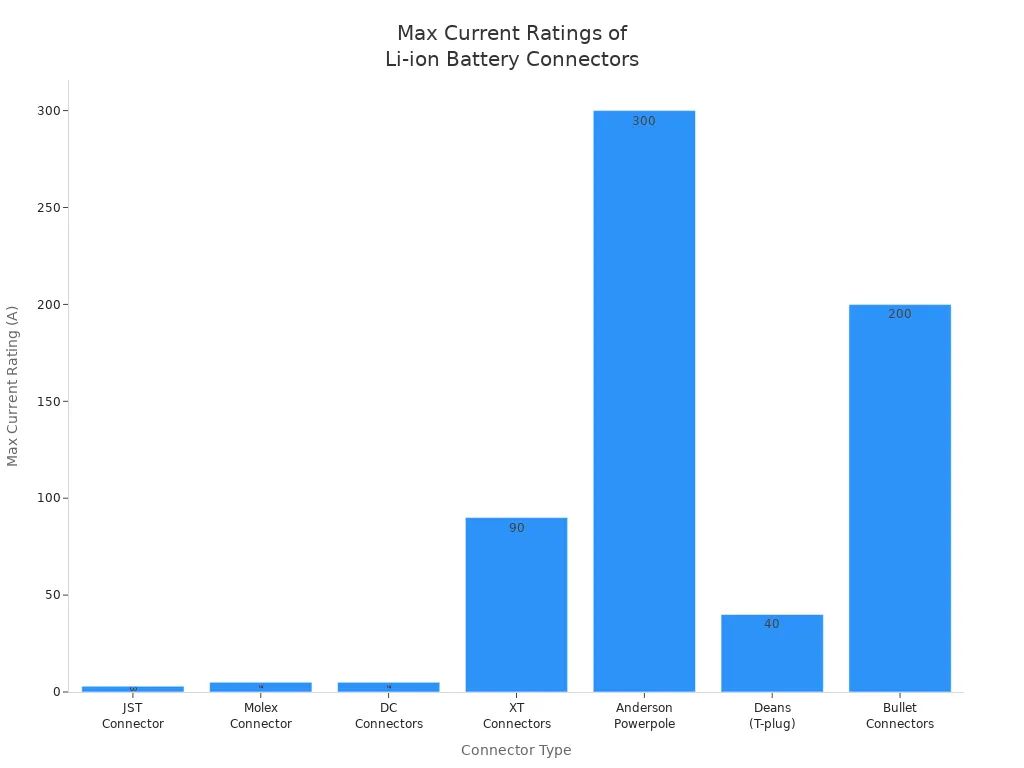
Design
You will notice that li-ion battery connectors come in many shapes and sizes. The design depends on the battery capacity, current, and safety needs. Some connectors use a locking mechanism to prevent accidental disconnection. Others focus on compact size for small devices. Many connector types use materials that resist heat and wear. This helps protect your battery and device during charging and use.
RC connectors like XT60 and Deans use thick metal contacts. These handle high current and support large battery capacity in hobby projects. JST and Molex connectors use smaller pins for lower current and smaller battery capacity. You should always match the connector design to your battery and device needs.
Tip: Always check the connector type and current rating before connecting your battery. This helps prevent overheating and damage.
Applications
You will see li-ion battery connectors in many places. Consumer electronics like smartphones, laptops, and tablets use small connectors for compact battery capacity. Hobby devices such as RC cars, drones, and robotics use RC connectors to handle high current and large battery capacity. Industrial machines, electric vehicles, and renewable energy systems need connectors that support high current and strong durability.
| Industry Sector | Primary Reasons for Using Li-ion Battery Connectors |
|---|---|
| Material Handling (Forklifts) | Handle higher thermal loads, support battery monitoring, durable for harsh environments, faster charging, electrification trend |
| Ground Support Equipment (Airport Operations) | Withstand moisture, dust, enable quick charging, support sustainability, meet regulations |
| Construction Equipment | Reduce noise, fast charging, improved durability, adapt to outdoor conditions |
| Agriculture | Heavy-duty use, long operation times, electric tractors and drones, high energy capacity and durability |
You will find that li-ion battery connectors help devices run longer, charge faster, and stay safe. Their many types and designs make them a top choice for both hobby and industrial uses.
LiPo Battery Connectors
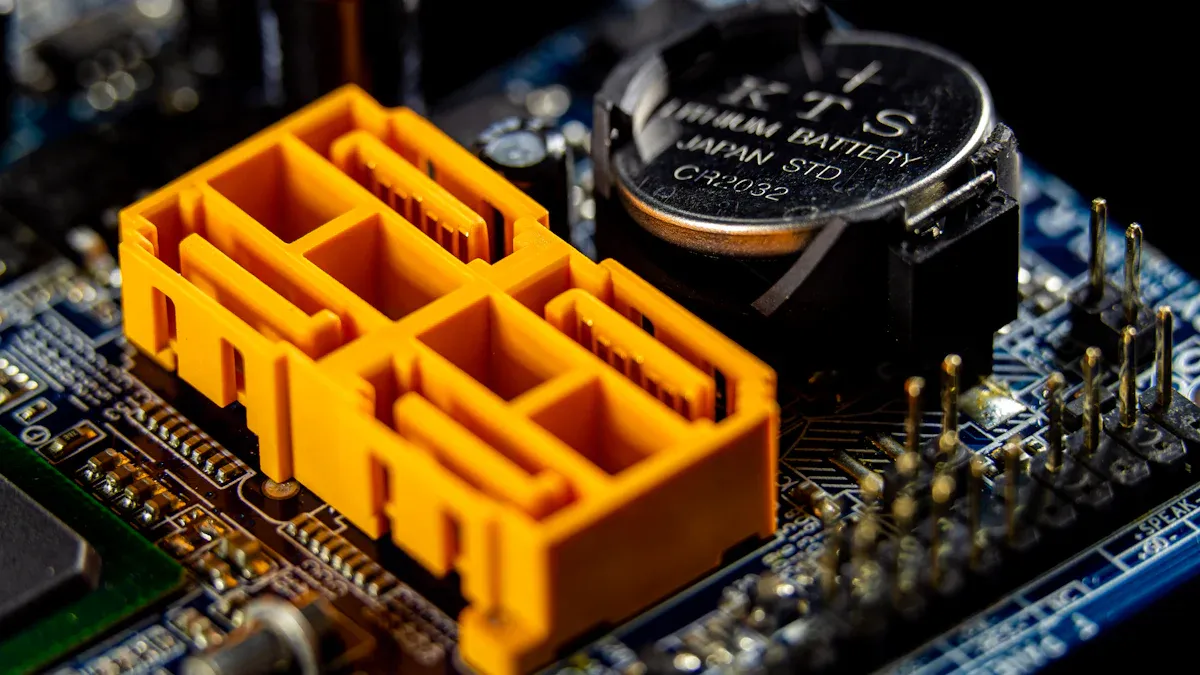
Main Power Connector
When you use a lipo battery, you will notice two main connectors. The first is the main power connector. This connector handles the high current flow from your lipo battery to your device. You will find several types of main power connectors in the hobby world, especially for RC cars and drones. Each connector type supports different current levels and battery capacity. The right choice depends on your device’s power needs and the size of your lipo battery.
Here is a table showing the most common main power connector types for lipo batteries:
| Connector Type | Typical Current Capacity | Common Applications | Key Characteristics and Suitability |
|---|---|---|---|
| XT60 | Up to 60A | Drones, RC cars | Durable, reliable, widely used for medium power applications |
| XT90 | Up to 90A | Large drones, RC trucks | Larger size, suitable for high-power applications |
| EC3 | Up to 60A | Small to medium RC vehicles | Affordable, compact, reliable |
| EC5 | Up to 120A | Mid-size RC vehicles, drones | Durable, handles higher current, larger than EC3 |
| EC8 | Up to 150A | Large RC vehicles, drones | Ideal for very high power, bulky size |
| JST | Low current | Small drones, low-power devices | Small, lightweight, efficient for low power |
| JR | Moderate current | RC systems | Reliable, handles moderate current, larger than JST |
| Deans | Moderate to high current | Hobby and RC applications | Compact design, secure connection |

You will often see XT60 connectors in drones and RC cars. JST connectors work well for small, low-power devices. If you need more battery capacity and higher current, you might use EC5 or EC8 connectors. RC connectors like Deans are popular in many hobby projects because they offer a secure fit and support high current.
Tip: Always match the connector type to your lipo battery’s current rating and battery capacity. This helps prevent overheating and keeps your device safe.
Balance Connector
The second connector on a lipo battery is the balance connector. This connector plays a key role in charging and safety. It connects to thinner wires that allow your charger or Battery Management System to monitor each cell in your lipo battery. The balance connector helps keep all cells at the same voltage. This prevents overcharging or undercharging any single cell, which protects your battery and extends its life.
During charging, the balance connector lets the charger check each cell’s voltage. If one cell has more charge, the charger can balance the cells by moving energy or releasing extra charge as heat. This process keeps your lipo battery safe and maintains its full battery capacity. Protection circuits will disconnect the battery if any cell reaches unsafe voltage levels. This prevents damage and reduces the risk of fire or failure.
Note: Using the balance connector every time you charge your lipo battery is important. It helps you get the most battery capacity and keeps your battery safe.
Applications
You will find lipo battery connectors in many high-performance applications. Lipo batteries are the top choice for RC cars, racing drones, and freestyle flying. These batteries deliver high current and support fast bursts of power. The connectors must handle this high current and battery capacity without overheating.
Lipo batteries have a polymer electrolyte. This allows flexible shapes and lightweight designs. You can fit them into small spaces in drones and hobby vehicles. The high discharge rate (C-rating) means your lipo battery can deliver a lot of current quickly. For example, a 5500mAh lipo battery with a 50C rating can safely provide 275A. This makes lipo batteries perfect for hobby projects that need peak power.
You will also see lipo battery connectors in robotics, electric skateboards, and other devices that need high battery capacity and fast charging. If you want to learn more about choosing the right connectors and battery capacity, a lipo battery guide can help you pick the best option for your hobby or project.
Remember: Lipo battery connectors are designed for high current, fast charging, and maximum battery capacity. Always use the correct connector for your lipo battery to keep your device safe and performing at its best.
Key Differences
Pin Configuration
You will notice that pin configuration is one of the most important differences between li-ion and lipo connectors. Li-ion connectors often use a simple two-pin setup for positive and negative terminals. This design works well for single-cell batteries or packs with built-in protection circuits. Lipo connectors, on the other hand, usually have more pins. The main power connector handles the high current, while the balance connector has extra pins for each cell. This setup allows you to monitor and balance each cell during charging. The extra pins in lipo connectors help keep your battery safe and extend its life. You should always match the pin configuration to your battery type to avoid connection errors and safety risks.
Size and Form
The size and form of connectors can affect how you design your device. Li-ion batteries, especially cylindrical types like 18650, use rigid metal cases. These batteries are strong and last a long time, but they take up more space. Their connectors are often standardized, which makes them easy to use but limits your design choices. Lipo batteries use flexible pouch cells. This means you can find lipo connectors in many shapes and sizes, such as XT60, JST, and EC3. You can choose a connector based on your device’s current rating, available space, and application needs. Lipo connectors give you more freedom to design slim, light, and compact devices. However, the soft pouch form of lipo batteries can get damaged more easily if you handle them roughly.
Tip: When you pick a connector, think about the pros and cons of each battery type. Li-ion connectors offer durability and cost savings, while lipo connectors give you more design flexibility.
| Battery Cell Type | Typical Sizes | Form Factor Characteristics | Pros | Cons | Typical Applications |
|---|---|---|---|---|---|
| Cylindrical | 18650, 21700, 26650 | Rigid metal cylinder, robust | High energy density, robust construction | Less efficient space use in packs | Laptops, power tools, EVs, flashlights |
| Prismatic | 103450, prismatic 18650 | Rectangular, better space utilization | Better space efficiency, easier integration in compact designs | Lower energy density than cylindrical | Smartphones, tablets, EVs |
| Pouch (LiPo) | Custom sizes | Flexible, lightweight pouch cells | Lightweight, flexible, customizable shapes and sizes | Less durable than cylindrical/prismatic | Wearables, smartphones, drones |
- Lipo battery connectors come in many types, such as XT60, JST, and EC3.
- You can pick a connector based on current rating, space, and your device’s needs.
- The variety of lipo connectors helps you optimize for size and electrical performance.
- Li-ion connectors are more standardized, which can limit design options but improve durability.
Current Rating
Current rating is a key factor when you choose connectors for your battery. Li-ion connectors often have lower current ratings because many devices use them for steady, moderate power. Lipo connectors, however, must handle high current for short bursts, especially in RC cars, drones, and other hobby devices. You will see connectors like XT30, XT60, and XT90 with current ratings from 30A to over 90A. EC3, EC5, and EC8 connectors can handle even more, up to 200A. If you use a connector with a current rating that is too low, your device may overheat or fail. Always check the current rating of your connector and make sure it matches or exceeds your device’s needs.
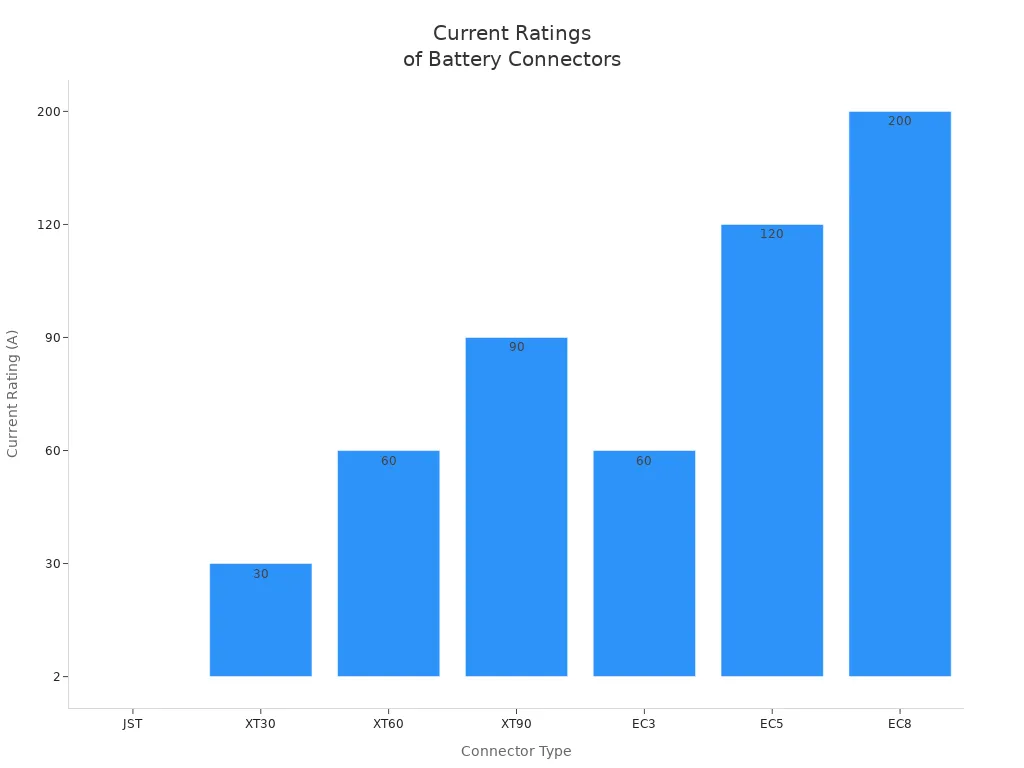
| Connector Type | Typical Current Rating | Application Impact |
|---|---|---|
| JST | Low current (small devices) | Good for low-power devices like small drones and RC cars. Not safe for high current needs. |
| XT30 | Up to 30A | Works well for small devices. Keeps operation safe within current limits. |
| XT60 | Up to 60A | Used in medium-power devices. Balances size and current rating for reliable performance. |
| XT90 | Over 90A | Designed for high-power devices. Handles high current safely. |
| EC3 | Around 60A | Good for lower current RC applications. Keeps connections stable. |
| EC5 | Up to 120A | Supports higher power safely. |
| EC8 | Over 200A | Needed for high-power devices. Critical for safety and performance. |
Note: Always select connectors with a current rating that matches or exceeds your device’s needs. This helps prevent overheating and keeps your battery safe.
Safety Features
Safety is a top concern when you work with li-ion and lipo batteries. Both types of connectors include features to protect you and your device. Li-ion connectors often work with a Battery Management System (BMS) that provides overcharge protection, temperature control, and current limiting. Lipo connectors, especially those with balance leads, help prevent overcharging and cell imbalance. Many connectors have locking mechanisms to stop accidental disconnection, which can cause short circuits or fires. Some connectors, like XT60 and XT90, use robust locking designs for extra safety in high-vibration environments.
| Safety Feature | Description |
|---|---|
| Overcharge Protection | BMS monitors voltage and stops charging at safe levels. |
| Temperature Control | Shuts down battery if it gets too hot. |
| Current Limiting | Controls current flow to prevent overheating. |
| Short Circuit Protection | Cuts off power if a short circuit happens. |
| Over-discharge Protection | Stops battery from dropping below safe voltage. |
| Cell Balancing | Keeps all cells at the same voltage during charging. |
Remember: Always inspect your connectors and battery packs before use. Damaged connectors can lead to short circuits and fires.
Compatibility
Compatibility between connectors and batteries is critical for device operation and user safety. You cannot swap li-ion connectors with lipo connectors without checking compatibility. Lipo batteries need connectors and chargers made for their chemistry. Using the wrong connector can cause short circuits, overheating, or even fire. Always check the current rating, size, and form factor before connecting. Manufacturer preferences and standardization help reduce risks. Never let positive and negative leads touch, as this can cause a dangerous short. Modifying connectors or using the wrong type can void warranties and increase the risk of accidents.
- Connectors must match the current rating of your device.
- Size and form factor must fit your battery and device.
- Always check datasheets for both battery and connector to confirm compatibility.
- Proper compatibility ensures reliable connections and prevents electrical faults.
Callout: The electrolyte inside your battery also affects connector design. Lipo batteries use a polymer electrolyte, which allows for flexible shapes and more connector options. Li-ion batteries use a liquid electrolyte, which needs a more rigid case and often uses standardized connectors.
When you choose connectors, always weigh the pros and cons of each type. Li-ion connectors offer durability and cost savings, but lipo connectors give you more design freedom and higher current ratings. Both types require careful attention to battery safety, charging, and current rating to keep your device running safely and efficiently.
Interchangeability
Risks
You might think swapping connectors between li-ion and lipo batteries is easy. This can lead to serious problems. Each connector is designed for a specific battery type. If you use the wrong connector, you put your device and yourself at risk.
Here are some dangers you face when you mix up connectors:
- Short circuits can happen if the connector pins do not match. This can cause sparks, heat, or even fire.
- Lipo batteries need balance charging. If you use a connector that does not support this, one cell may overcharge or undercharge. This can damage the battery or cause it to swell.
- Li-ion batteries often have built-in protection. Lipo batteries usually do not. If you use a lipo battery with a connector meant for li-ion, you lose important safety features.
- Using the wrong connector can make your device overheat. This can melt wires or damage the battery.
- Some connectors cannot handle the high current from a lipo battery. This can cause the connector to fail or burn.
⚠️ Always check your connectors before use. Never swap connectors without making sure they match your battery type.
Considerations
Before you try to change connectors or use a different connector with your lipo battery, you need to think about several important points. These steps help you avoid damage and keep battery safety as your top priority.
- Inspect your battery and connectors for any damage, swelling, or odd shapes. Damaged parts can start fires or ruin your battery.
- Use a digital voltmeter to check the battery voltage. Do not charge or use a battery if any cell is below 3.3V.
- Only use chargers made for your battery type. For lipo batteries, always use balance charging with the correct connector.
- Never mix or swap connectors unless you are sure they are compatible. Improper connectors can cause short circuits or fires.
- Charge your battery in a fireproof container. Never leave it alone while charging.
- Do not let your battery discharge below safe voltage. This can cause hidden damage that may lead to fire later.
- Never use chargers made for other battery types, like NiCd or NiMH, with lipo or li-ion batteries. Always follow the instructions from the manufacturer.
- Do not take apart battery packs or mix cells from different packs. This can break the safety system and damage the battery.
- Store and move your batteries in fireproof bags. Keep them away from heat and sunlight.
- Use low voltage alarms or monitors to keep track of your battery health.
Tip: Always match your connector to your battery type and device. This helps you avoid costly mistakes and keeps you safe.
If you ignore these steps, you risk damaging your battery, your device, or even causing a fire. Lipo batteries need special care because they can release a lot of energy quickly. The right connector helps control this energy and keeps your battery safe. Li-ion batteries also need the correct connector to work with their built-in safety systems.
When you choose connectors, always think about the current rating, pin layout, and charging needs. Never guess or use a connector just because it fits. The wrong connector can cause poor performance, overheating, or even explosions. Battery safety should always come first.
Choosing the Right Connector
Matching Connector to Battery
You need to match the right connector to your battery for safe and reliable performance. Start by checking your device’s power needs and the type of battery you use. Follow these steps to make the best choice:
- Assess your application’s current load, connection type, and environment.
- Read the battery manufacturer’s manual for recommended connector types and configurations.
- Inspect your battery’s terminals. Look for studs, blades, posts, or flat contacts.
- Make sure the connector fits both the battery and the device. A poor fit can cause damage or weak connections.
- Think about where you will use the battery. If you expect vibration, moisture, or heat, pick connectors made for those conditions.
- Choose a connector that matches your application, such as plug-and-socket or automotive types. Quality and reliability matter.
- Use connector catalogs and datasheets to find the right match. Ask an expert if you are unsure.
- Measure terminals carefully and check for locking features to keep connections secure.
- Always connect with the correct polarity and use proper insulation.
- Use the right tools for installation to avoid damaging the connector or battery.
Tip: Following these steps helps you avoid common problems and keeps your lipo battery working at its best.
Application Tips
When you select connectors for your lipo battery, think about your device’s needs and the environment. Experts suggest these tips:
- Keep enough space between high-voltage connectors and other parts to prevent arcing. For example, use at least 8mm clearance and 10mm creepage distance.
- Place high-voltage connectors near the edge of your circuit board to reduce interference.
- Separate high-voltage and low-voltage connectors to avoid cross-talk.
- Use strong connectors like XT60 or Anderson Powerpole for high current and capacity.
- Pick waterproof or weather-resistant connectors for outdoor use, such as MC4 connectors.
- Match the connector size to your device. Small devices may use USB or DC barrel connectors, while high-power devices need larger connectors.
- Maintain connectors by checking for corrosion and cleaning them often. Use anti-corrosion sprays in harsh environments.
A good connector choice improves safety, performance, and battery life. If you want to know how to choose a lipo battery for a special project, always check the current rating and capacity first.
Common Mistakes
Many users make mistakes when choosing or installing connectors for li-ion and lipo batteries. These errors can lower performance or cause safety risks. Watch out for these common problems:
- Loose or poor connections reduce current flow and can cause power loss.
- Corrosion increases resistance and damages connectors.
- Overtightening fasteners can break terminals.
- Picking the wrong connector type for your application leads to weak or unsafe connections.
- Not understanding the difference between terminals and lugs adds extra failure points.
You can avoid these cons by following best practices:
- Choose the right connector type for your battery and application.
- Make sure all connections are clean, tight, and secure.
- Use dielectric grease to stop corrosion.
- Inspect connectors often and fix any loose or damaged parts.
- Use corrosion-resistant hardware and avoid overtightening.
Callout: Good connector choices bring many pros, like longer battery life, better capacity, and safer charging. Avoiding these cons helps you get the most from your lipo battery and device.
You now know that lipo and li-ion connectors serve different roles. Lipo connectors often include both a main power connector and a balance connector, while li-ion connectors usually have a simpler design. The table below highlights key features and usage for popular connector types:
| Connector Type | Key Features & Usage | Polarity Protection | Notes |
|---|---|---|---|
| XT60 | Reliable, easy to use, up to 60A | One-way connection | Popular in lipo battery packs |
| Deans | Handles 60A+, corrosion resistant | Difficult to solder | Trusted for RC applications |
| EC3 | Strong market presence, up to 60A | Cumbersome assembly | Used in many lipo devices |
You should never swap connectors between lipo and li-ion packs without checking compatibility. Using the wrong connector can cause overheating or fire. Always match your connector to your lipo battery and device needs. If you feel unsure, consult your device manual or ask an expert before making changes.
Tip: Protect your connectors and store your lipo battery in a cool, dry place to prevent damage.
FAQ
Can you use a LiPo connector on a Li-ion battery?
You should not use a LiPo connector on a Li-ion battery. Each connector matches a specific battery type. Using the wrong connector can cause safety problems, poor charging, or even fire.
Why do LiPo batteries have balance connectors?
LiPo batteries use balance connectors to keep each cell at the same voltage. This helps prevent overcharging or undercharging. Balanced charging makes your battery last longer and keeps it safe.
How do you know which connector your battery needs?
Check your device manual or battery label. Look for the connector type and current rating. You can also compare the connector shape and pin layout. If you feel unsure, ask an expert.
What happens if you connect the wrong battery connector?
⚠️ Using the wrong connector can cause short circuits, overheating, or fire. Your device may not work, or the battery could get damaged. Always double-check before connecting.
Are there universal connectors for Li-ion and LiPo batteries?
No universal connector fits both battery types. Each battery uses connectors designed for its voltage, current, and safety needs. Always use the connector recommended by your battery or device manufacturer.

